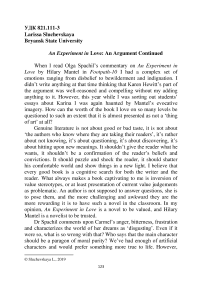An experiment in love: an argument continued
Автор: Sluchevskaya Larissa
Журнал: Тропа. Современная британская литература в российских вузах @footpath
Рубрика: Debate and controversy
Статья в выпуске: 12, 2019 года.
Бесплатный доступ
The paper continues an argument about the meaning and artistic value of Hilary Mantel’s novel An Experiment in Love begun in Footpath-10.
Hilary mantel, value judgement, modelling reality
Короткий адрес: https://sciup.org/147231139
IDR: 147231139 | УДК: 821.111-3
Текст научной статьи An experiment in love: an argument continued
Dr Spachil claims that Mantel’s characters are heading towards a ‘loveless’ world. Is it intentional (or unintentional?) irony to speak like this about the novel whose title is An Experiment in Love? I disagree. I look upon this wonderful novel as a book about love and women’s ‘faculty for love’ [Mantel 2010: 56]. How can the following passage go along with the idea of a loveless world?
Even today, there are ten or twenty women I love: for a turn of phrase or wrist, for a bruised-looking ankle where the veins have blossomed out, for a squeeze of the hand or for a voice on the end of the phone. I would no more go to bed with any of them than I would drown myself; and drowning is my most feared form of death. Perhaps I love too easily… [Mantel 2010: 56]
If we agree with Dr Spachil, what shall we make out of the recurrent question of the novel ‘Who is my neighbour?’?
There is one more thing I want to point out. We shouldn’t look upon the imaginary world of a book as something taken from real life. It is not a reflection of life. It is a model of life. The author is modelling reality and this fictionality has its inner logic that is not the same as the logic of the world we live in. That is why I don’t think one should use an allusion to Hitler’s concentration camps as a means of reinforcing one’s idea in a literary argument.
The novel touches upon many issues that were burning in the 1970s but many of them haven’t actually gone away. They have their resonating presence in today’s world. A novel like this can’t possibly give a clear message, it has clues to multiple interpretations, which gives a reader cognitive pleasure. For example, one of the issues dwelt upon by Dr Spachil is virginity. She wonders why Carmel hates her virginity and quotes Carmel’s speculation on loss of virginity as a career move. To understand Carmel’s attitude, the reader, on the one hand, shouldn’t forget that there is a gap of time and life experience between Carmel the narrator and Carmel the teenager, and, on the other hand, should place the concept of virginity in a feminist discourse. Then virginity becomes not a matter of liking and hating but a social construct that is viewed in the context of the sexual double standard and sexism. It is still a matter of fierce controversy.
Finally, the novel’s publication date is certainly not an argument in favour of its value but its unique language surely is. An Experiment in Love is a novel to savour. It’s an aesthetic delight that has to do more with truth and precision than beauty (Do I sound like an echo of David Mitchell’s Madame Crommelynck?). Would you ever think of comparing someone’s manner of speaking to the effect of putting your finger underneath the tap to trap the water [Mantel 2010: 46]? Can narrative be like knitting done in a bad temper [Mantel 2010: 50]? Mantel shows that it can and does many other things besides.
It seems to me that Mantel has this exceptional ability to create a palpitating image out of ‘ordinary words’. The following is a brilliant example of her ingenuity: I had to trail along behind her, dragging the suitcase like a deformed limb [Mantel 2010: 4]. The author tells us so much about Carmel’s feelings without actually speaking about them. We can provoke a heated argument if we ask students how they would feel if they had a deformed limb. Only, in the heat of the discussion, try not to lose the suitcase!
In a novel like this the reader must be always alert. In the fictional world of the novel every object matters. If there is a scull, maybe, the author sets the scene for a tragedy. If a fur-coat is described in detail, it’s going to play its special role. And the big wooden fob of a key can become a clue to a mystery.
The red cover of the book cries for our attention and this time the blurb has it right: it’s a book to be treasured.
Список литературы An experiment in love: an argument continued
- Mantel H. An Experiment in Love. L.: Fourth Estate, 2010.
- Spachil O. On Hilary Mantel's Novel An Experiment in Love: An Argument // Footpath. 2017. Issue 10 (5). P. 61-64.


